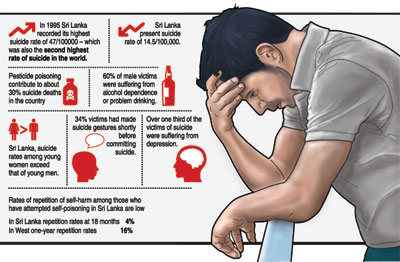News
Sri Lanka hits world record in attempted suicides — depression, alcohol abuse main causes
A significant number of suicide cases in Sri Lanka are associated with depression and alcohol dependence, with 60 percent of the victims being males.
In separate studies done by the Medical Faculty of the Peradeniya University and the Chilaw General Hospital, it has been found that a majority of the men who took their lives or attempted to do so were alcohol dependents.
Consultant Psychiatrist and Peradeniya University lecturer Dr. Thilini Rajapakse, and the Chilaw Hospital’s Consultant Psychiatrist Dr. Prabath Wickrema revealed these figures in a document titled ‘Suicide Prevention in Sri Lanka: What should we do’.
They said that the most dangerous aspect of their findings was that while eight people committed suicide every day, there were 164 who attempted to commit suicide and this was the highest in the world.
The rate of self-harm by poisoning, especially among young people appears to have increased over the past decade with two thirds of those admitted to hospital being below 30 years. As in other parts of the world, in Sri Lanka, too, the suicide rate among men is more than among women, with an average of four males taking their lives for every female. However, it has been found the suicide rate among females in the age group 10 to 19 has increased. Among women, the rates decline with age.
Suicide rates among older men is higher than among older women.
The study reveals that the suicide rate among young women is high due to gender role issues in a complex, changing society. This includes conflict between traditional expectations of the role of the woman and difficulty in communicating distress or dissent in a patriarchal society.
In an earlier study by Dr. Ranil Abeyasinghe of the University of Peradeniya and Dr. Sudath Samaraweera of the Epidemiology Unit of the Health Ministry, it was found that one third of suicide victims had been suffering from depression. Of them, 10 percent had severe depression and about 38 percent mild or moderate depression.
Chilaw Hospital’s Dr. Wickrema said that to minimise suicide and attempted suicide in Sri Lanka, it was important to identify the multiple factors associated with them.
In 1995, Sri Lanka was ranked second highest in the world with 25 people taking their lives every day, a majority by consuming toxic pesticide. With the government taking measures to restrict the availability of pesticides, the numbers dropped gradually over the years.
In the first six months of this year, 1,597 cases of suicides were reported with 1,275 victims being males and 322 females. Improvement in medical services and increased accessibility to medical care have also contributed to the decline. A majority of the suicides were by hanging and a significant number by medicinal overdose according to these studies.
The attempted suicide repetition rate among Sri Lankans is low — 4% at 18 months of follow up — compared to a repetition rate of 16% — or a followup of 12 months — in most western countries.
Current studies show that the underlying factors for suicide are multiple and complex and cannot be attributed to a single issue. Factors include, disagreement between spouses, financial problems, failure in exams among other issues.
Inability to seek community help, domestic violence and inability to cope are factors that compound the problems in the backdrop of socio-economic hardships in the home environment, studies show.
Dr. Abeyasinghe’s study revealed that 34 percent of the victims had indicated to those close to them a desire to commit suicide before they took their lives. This indicates the importance of taking prompt action if somebody close or a family member expressed suicidal thoughts.
Many of those who had attempted suicide and were admitted to hospitals had been driven by relationship problems often with a spouse, partner, parent or child.
The studies showed people often had mixed motivations – including an intention to die, or to change someone’s mind to show helplessness and to make another feel sorry.
Suicide prevention should include effective interventions that have contributed to the decline in numbers, the studies recommended. They also proposed restriction in the availability of toxic pesticides and improving medical services to treat victims. The ability to identify depression and alcohol problems and make available necessary treatment and counselling were also proposed.
Teaching children, adolescents and young people how to cope with inter-personal conflicts is another area to look into. Introducing a subject in schools and creating awareness and skills to cope with modern day stress and empowering the community one lives in would also contribute much in suicide prevention, the studies said.
Innovative methods should be used to help families, particularly parents and children, to cope with and solve conflict.

